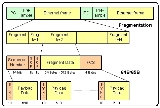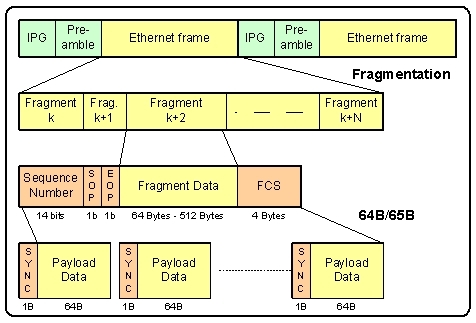
PME Aggregation Function
Encyclopedia
PME Aggregation Function (PAF) is a mechanism defined in Clause 61 of IEEE 802.3
, which allows one or more Physical Medium Entities (PMEs) to be combined together to form a
single logical Ethernet
link.
The PAF is located in the Physical Coding Sublayer
(PCS), between the Media Access Control
(MAC)-PHY
Rate Matching function and the Transmission Convergence (TC) sublayer. It interfaces with the PMEs across the λ-interface, and to the MAC-PHY Rate Matching function using an abstract interface.
PAF is an optional function which is currently (2007) defined for two IEEE 802.3 interfaces: 2BASE-TL
and 10PASS-TS
, both of which are EFM
copper PHY
s.
PAF Transmit function works by fragmenting incoming Ethernet frames into a number of fragments, limited in size to a range between 64 and 512 Bytes. A sequential fragmentation header is prepended to each fragment, indicating if the fragment is from the start-of-packet, end-of-packet or middle of packet. A Frame Check Sequence
(FCS) is appended to each fragment, which is then transmitted by the next available active PME in the aggregated group.
The following diagram illustrates the PAF fragmentation:
 PAF Receive function reassembles the original frames from the received fragments, which are buffered in a per-MAC fragment buffer. The algorithm uses the fragmentation header to make sure that the reassembled frames are in order.
PAF Receive function reassembles the original frames from the received fragments, which are buffered in a per-MAC fragment buffer. The algorithm uses the fragmentation header to make sure that the reassembled frames are in order.
It was later referenced by ITU-T
G.998.2 (Ethernet-based multi-pair bonding) and its ANSI
equivalent NIPP-NAI T1.427.02.
PAF is an asymmetric protocol, i.e. all information required for reassembly is contained in the fragmentation header sent with each fragment. While allowing great flexibility in Transmitter and Receiver implementations it requires an overhead consuming about 5% of the bandwidth (estimation for 2BASE-TL protocol, including 64B/65B encapsulation). PAF is optimized for the Ethernet traffic.
Inverse Multiplexing for ATM
(IMA) is another aggregation protocol, which unlike PAF uses fixed size cells, sending them across multiple links in a Round-Robin
fashion. IMA is optimized for ATM
and in the extreme cases (short Ethernet frames) may add as much as 40% overhead due to the AAL5 encapsulation.
ITU-T G.998.3 (Multi-pair bonding using time-division inverse multiplexing) specification, a.k.a. G.Bond/TDIM, defines a symmetric aggregation protocol, in which both sides of a point-to-point link exchange information about the aggregation, so there's no need for a separate header. G.Bond/TDIM is optimized for both Time-Division Multiplexing
and packet traffic with less than 3% overhead (estimation for Ethernet traffic, including Generic Framing Procedure
(GFP) encapsulation).
IEEE 802.3
IEEE 802.3 is a working group and a collection of IEEE standards produced by the working group defining the physical layer and data link layer's media access control of wired Ethernet. This is generally a local area network technology with some wide area network applications...
, which allows one or more Physical Medium Entities (PMEs) to be combined together to form a
single logical Ethernet
Ethernet
Ethernet is a family of computer networking technologies for local area networks commercially introduced in 1980. Standardized in IEEE 802.3, Ethernet has largely replaced competing wired LAN technologies....
link.
The PAF is located in the Physical Coding Sublayer
Physical Coding Sublayer
- Description :The Physical Coding Sublayer further helps to define physical layer specifications for networking protocols like Fast Ethernet, Gigabit Ethernet and 10 Gigabit Ethernet....
(PCS), between the Media Access Control
Media Access Control
The media access control data communication protocol sub-layer, also known as the medium access control, is a sublayer of the data link layer specified in the seven-layer OSI model , and in the four-layer TCP/IP model...
(MAC)-PHY
PHY
PHY is an abbreviation for the physical layer of the OSI model.An instantiation of PHY connects a link layer device to a physical medium such as an optical fiber or copper cable. A PHY device typically includes a Physical Coding Sublayer and a Physical Medium Dependent layer. The PCS encodes and...
Rate Matching function and the Transmission Convergence (TC) sublayer. It interfaces with the PMEs across the λ-interface, and to the MAC-PHY Rate Matching function using an abstract interface.
PAF is an optional function which is currently (2007) defined for two IEEE 802.3 interfaces: 2BASE-TL
2BASE-TL
2BASE-TL is an IEEE 802.3-2008 Physical Layer specification for a full-duplex long reach point-to-point Ethernet link over voice-grade copper wiring...
and 10PASS-TS
10PASS-TS
10PASS-TS is an IEEE 802.3-2008 Physical Layer specification for a full-duplex short reach point-to-point Ethernet link over voice-grade copper wiring, used in Ethernet in the first mile applications....
, both of which are EFM
Ethernet in the First Mile
Ethernet in the first mile refers to using one of the Ethernet family of computer network protocols between a telecommunications company and a customer's premise. From the customer's point of view it is their "first" mile, although from the access networks' point of view it is known as the "last...
copper PHY
PHY
PHY is an abbreviation for the physical layer of the OSI model.An instantiation of PHY connects a link layer device to a physical medium such as an optical fiber or copper cable. A PHY device typically includes a Physical Coding Sublayer and a Physical Medium Dependent layer. The PCS encodes and...
s.
Details
PME Aggregation function has the following characteristics:- Supports aggregation of up to 32 PMEs
- Supports individual PMEs having different data rates (max 1:4 ratio)
- Ensures low packet latency and preserves frame order
- Scalable and resilient to PME failure
- Independent of type of EFM copper PHY
- Allows vendor discretionary algorithms for fragmentation
PAF Transmit function works by fragmenting incoming Ethernet frames into a number of fragments, limited in size to a range between 64 and 512 Bytes. A sequential fragmentation header is prepended to each fragment, indicating if the fragment is from the start-of-packet, end-of-packet or middle of packet. A Frame Check Sequence
Frame Check Sequence
A frame check sequence refers to the extra checksum characters added to a frame in a communication protocol for error detection and correction. Frames are used to send upper-layer data and ultimately the user application data from a source to a destination. The data package includes the message...
(FCS) is appended to each fragment, which is then transmitted by the next available active PME in the aggregated group.
The following diagram illustrates the PAF fragmentation:

History
The PME Aggregation function was first defined in IEEE 802.3ah in 2004. The original Loop Aggregation proposal was submitted by Klaus Fosmark from now defunct First Mile Systems in 2001.It was later referenced by ITU-T
ITU-T
The ITU Telecommunication Standardization Sector is one of the three sectors of the International Telecommunication Union ; it coordinates standards for telecommunications....
G.998.2 (Ethernet-based multi-pair bonding) and its ANSI
Ansi
Ansi is a village in Kaarma Parish, Saare County, on the island of Saaremaa, Estonia....
equivalent NIPP-NAI T1.427.02.
Comparison
PAF algorithm and fragmentation header are very similar to MLPPP which works at layer 3 (IP).PAF is an asymmetric protocol, i.e. all information required for reassembly is contained in the fragmentation header sent with each fragment. While allowing great flexibility in Transmitter and Receiver implementations it requires an overhead consuming about 5% of the bandwidth (estimation for 2BASE-TL protocol, including 64B/65B encapsulation). PAF is optimized for the Ethernet traffic.
Inverse Multiplexing for ATM
Inverse Multiplexing for ATM
IMA is a standardized technology used to transport ATM traffic over a bundle of T1 or E1 cables, also known as IMA Group. This allows for gradual increase in line capacity, where implementing a high-capacity solution is not deemed feasible...
(IMA) is another aggregation protocol, which unlike PAF uses fixed size cells, sending them across multiple links in a Round-Robin
Round-robin
The term round-robin was originally used to describe a document signed by multiple parties in a circle to make it more difficult to determine the order in which it was signed, thus preventing a ringleader from being identified...
fashion. IMA is optimized for ATM
Asynchronous Transfer Mode
Asynchronous Transfer Mode is a standard switching technique designed to unify telecommunication and computer networks. It uses asynchronous time-division multiplexing, and it encodes data into small, fixed-sized cells. This differs from approaches such as the Internet Protocol or Ethernet that...
and in the extreme cases (short Ethernet frames) may add as much as 40% overhead due to the AAL5 encapsulation.
ITU-T G.998.3 (Multi-pair bonding using time-division inverse multiplexing) specification, a.k.a. G.Bond/TDIM, defines a symmetric aggregation protocol, in which both sides of a point-to-point link exchange information about the aggregation, so there's no need for a separate header. G.Bond/TDIM is optimized for both Time-Division Multiplexing
Time-division multiplexing
Time-division multiplexing is a type of digital multiplexing in which two or more bit streams or signals are transferred apparently simultaneously as sub-channels in one communication channel, but are physically taking turns on the channel. The time domain is divided into several recurrent...
and packet traffic with less than 3% overhead (estimation for Ethernet traffic, including Generic Framing Procedure
Generic Framing Procedure
Generic Framing Procedure is a multiplexing technique defined by ITU-T G.7041. This allows mapping of variable length, higher-layer client signals over a circuit switched transport network like OTN, SDH/SONET or PDH...
(GFP) encapsulation).
External links
- Get IEEE 802.3 - "IEEE Standard for Information technology - Telecommunications and information exchange between systems - Local and metropolitan area networks - Specific requirements - Part 3: Carrier Sense Multiple Access with Collision Detection (CSMA/CD) Access Method and Physical Layer Specifications", IEEE Std 802.3-2008, November 2008.
- IEEE 802.3ah - Ethernet in the First Mile Task Force archive

